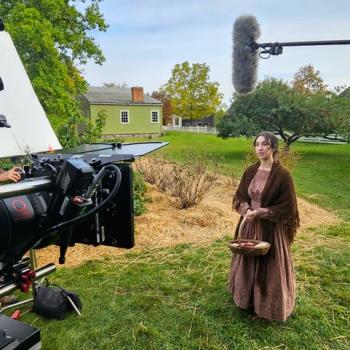
These new articles went up today on the website of the Interpreter Foundation. As always, they are easily accessible, at absolutely no charge:
““Behold, He Was a Man Like unto Ammon”: Mormon’s Use of ʾmn-related Terminology in Praise of Moroni in Alma 48,” written by Matthew L. Bowen
Abstract: This article examines Mormon’s comparison of Moroni, the Nephite military leader, to Ammon, the son of Mosiah, in Alma 48:18 and how Mormon’s use and repetition of ʾmn-related terminology (“faithful,” “firm,” “faith,” “verily [surely]”) in Alma 48:7–17 lays a foundation for this comparison. Ammon’s name, phonologically and perhaps etymologically, suggests the meaning “faithful.” Mormon goes to extraordinary lengths in the Lamanite conversion narratives to show that Ammon is not only worthy of this name, but that his faithfulness is the catalyst for the transition of many Lamanites from unbelief to covenant faithfulness. Thus, in comparing Moroni directly to Ammon, Mormon makes a most emphatic statement regarding Moroni’s covenant faithfulness. Moreover, this comparison reveals his admiration for both men.
“Interpreting Interpreter: Like Unto Ammon,” written by Kyler Rasmussen
This post is a summary of the article ““Behold, He Was a Man Like unto Ammon”: Mormon’s Use of ʾmn-related Terminology in Praise of Moroni in Alma 48” by Matthew L. Bowen in Volume 58 of Interpreter: A Journal of Latter-day Saint Faith and Scholarship. All of the articles may be seen at https://interpreterfoundation.org/category/summaries/. An introduction to the Interpreting Interpreter series is available at https://interpreterfoundation.org/interpreting-interpreter-on-abstracting-thought/.
The Takeaway: Bowen argues that the comparison between Captain Moroni and Ammon in Alma 48 could leverage the terms “faithful,” “firm,” “faith,” and “verily,” all of which include the sound ‘mn in Hebrew, to strengthen the connection between these prophetic figures.
“Centered on Christ: The Book of Enos Possibly Structured Chiastically,” written by Stephen Kent Ehat
Abstract: The book of Enos is considered to be a short, one-chapter treatise on prayer, yet it is more. Close examination of its text reveals it to be a text structurally centered on Christ and the divine covenant. Enos seeks and obtains from Him a covenant to preserve the records of the Nephites for the salvation of the Lamanites. Enos prays not only for his own remission of sins but also for the salvation both of his own people, the Nephites, and also of the Lamanites. He yearns in faith that the Lord will preserve the records of his people for the benefit of the Lamanites. This article outlines a possible overall chiastic structure of vv. 3–27 as well as a centrally situated smaller chiasm of vv. 15–16a, which focus on Christ and His covenant with Enos. The voice of the Lord speaks to the mind of Enos seven times, and the proposed chiastic structure of the text is meaningfully related to those seven divine communications. We have the Book of Mormon in our day because of the faithful prayers and faithful labors of prophets like Enos and because of the promises they received from Christ, whose covenant to preserve the records is made the focal point at the center of the Enos text.
“Interpreting Interpreter: A Chiastic Enos,” written by Kyler Rasmussen
This post is a summary of the article “Centered on Christ: The Book of Enos Possibly Structured Chiastically” by Stephen Kent Ehat in Volume 58 of Interpreter: A Journal of Latter-day Saint Faith and Scholarship. All of the articles may be seen at https://interpreterfoundation.org/category/summaries/. An introduction to the Interpreting Interpreter series is available at https://interpreterfoundation.org/interpreting-interpreter-on-abstracting-thought/.
The Takeaway: Ehat argues that the Book of Enos is structured as a conceptual chiasm, one in which Enos prays first for his personal redemption, then for redemption of his people the Nephites, and finally for redemption of the Lamanites, and then in reverse sequence, Enos details the efforts and promises to redeem each of those, with the chiasm centered on Christ and his covenant to preserve the Nephite record.
Speaking on behalf of the Interpreter Foundation, I wish all of you a wonderful conference weekend.

I very much enjoyed these two articles, both of them published in the Deseret News:
“Perspective: Latter-day Saints aren’t going anywhere. Look at the numbers: Utah, where 56% of the state affiliates with The Church of Jesus Christ of Latter-day Saints, has the highest rate of weekly church attendance in the country,” by the always-interesting Jacob Hess and Stephen Cranney
Many elements in this account of Elder Bednar’s interview remarks interested me, but here’s something that particularly caught my attention because of the Interpreter Foundation’s other current film project, which is entitled Not By Bread Alone: Stories of the Saints in Africa:
““In my particular responsibility, we’re always thinking 20, 30, 50 years down the road,” Elder Bednar said. From that perspective, he noted a possible change because of significant future growth in Africa.
““Today, the dominant language in the church is Spanish, not English,” he said. “I think in the future it may be French,” because of the growing number of members in African countries that are former French-speaking colonies.”
The actual on-location filming for Not By Bread Alone is pretty much complete, but a great deal remains still to be done and — just as for the much larger project Six Days in August — we still need to raise money to cover “post-production.” The result, in the case of Not By Bread Alone, will not be a single theatrical film but a series of relatively short videos in both French (for our African friends in the Congo) and English, which we plan to make available online at no charge.
If you are interested in helping financially with either of these projects — or, of course, with the work of the Interpreter Foundation more generally — please go to “Donating to The Interpreter Foundation” to find out how you can do it. We would really appreciate the help, even if it’s only a few dollars. (Or, borrowing a tip from Senator Robert Menendez [D-NJ], a few gold bars.) In fact, of course, we need help. Our work doesn’t get done without a lot of people pitching in, wherever and however they can.












